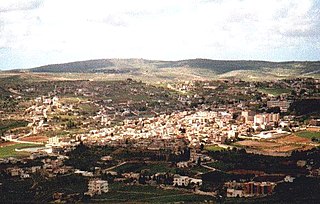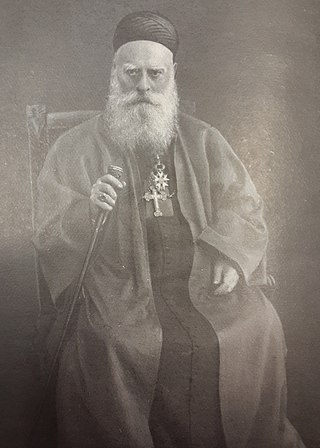Battle of Maroun al-Ras may refer to:
- Battle of Maroun al-Ras (2006), a battle of the 2006 Lebanon War
- Battle of Maroun al-Ras (2024), a battle during the 2024 Israeli invasion of Lebanon
Battle of Maroun al-Ras may refer to:

Southern Lebanon is the area of Lebanon comprising the South Governorate and the Nabatiye Governorate. The two entities were divided from the same province in the early 1990s. The Rashaya and Western Beqaa districts, the southernmost districts of the Beqaa Governorate.

The Lebanese Broadcasting Corporation International, widely known as LBCI, is a private television station in Lebanon. LBCI was founded in 1992 by acquiring the assets, liabilities and logo of LBC, an entity founded in 1985 during the Lebanese Civil War by the Lebanese Forces militia. LBCI went global in 1996 when it launched its satellite channel LBC Al-Fadha'iya Al-Lubnaniya covering Lebanon, the Arab world, Europe, America, Australia and Africa.
Abboud, Aboud, or `Ābūd is an Arabic nickname to any Arabic name that starts with Abdul Abdel Abdal. Instances include:

Maroun El Ras is a Lebanese village nestled in Jabal Amel in the district of Bint Jbeil in the Nabatiye Governorate in southern Lebanon. It is located around 120 km (75 mi) south east of Beirut, roughly one km (0.62 mi) from the border with Israel.

Bint Jbeil is the second largest town in the Nabatiye Governorate in Southern Lebanon.

The Battle of Bint Jbeil was one of the main battles of the 2006 Lebanon War. Bint Jbeil is a major town of some 20,000 inhabitants in Southern Lebanon. Although Brig.-Gen. Gal Hirsch announced on 25 July that the Israel Defense Forces (IDF) had "complete control" of Bint Jbeil, this statement was later discredited. In spite of three sustained attempts by the IDF to conquer the town, it remained in the hands of Hezbollah until the end of the war. The town was the scene of some of the fiercest fighting of the war, with both sides taking heavy losses. Three senior Israeli officers, including Major Roi Klein, were killed in the battle. Hezbollah similarly lost several commanders, most notably Khalid Bazzi, commander of the Bint Jbeil area.

The Battle of Maroun al-Ras was a battle of the 2006 Lebanon War that took place in Maroun al-Ras, a small village in southern Lebanon on the border with Israel, and Jall ad-Dayr, a nearby Hezbollah stronghold. This battle was the first serious ground battle in the 2006 Lebanon war. It was fought to a large extent by elite forces on both sides and would have huge consequences for the future of the war. Although Israeli forces captured most of the town, they did not fully secure it.

Avivim is a moshav in Israel, in the northernmost part of Upper Galilee, less than one kilometre from the Blue Line with Lebanon. In 2022, its population was 474.

Elias Peter Hoayek was the 72nd Maronite Catholic Patriarch of Antioch from 1898 until his death in 1931.

The Bint Jbeil District is a district in the Nabatiyeh Governorate of Lebanon. The capital of the district is Bint Jbeil.
The Lebanese Youth Movement – LYM (Arabic: حركة الشباب اللبنانية | Harakat al-Shabab al-Lubnaniyya), also known as the Maroun Khoury Group (MKG), was a Christian far-right militia which fought in the 1975-77 phase of the Lebanese Civil War.
The Benji Hillman Foundation (BHF) was founded in August 2006, in memory of Major Benji Hillman, who was killed in action during the 2006 Lebanon War. The Foundation's aims are to help lone combat soldiers and soldiers from deprived backgrounds in the Israel Defense Forces, both during and after their army service.
Ghanem is a masculine given name and a surname. It may refer to:

Nejmeh Sporting Club is a football club based in Manara, a neighbourhood in Ras Beirut, Beirut, Lebanon, that competes in the Lebanese Premier League.
Hezbollah Nature Reserves were a system of Hezbollah strongholds built in southern Lebanon between the Israeli withdrawal from Lebanon 2000 and the 2006 Lebanon war. The term "Nature Reserve" was originally IDF slang and refer to the fact that they were primarily placed in the countryside away from habitation and were declared off-limits to the IDF during the war, due to fear of high casualties.
Khalid Ahmad Bazzi was a Lebanese military commander who was the commander of Hezbollah's military wing, the Islamic Resistance in Lebanon. In the 2006 Lebanon War, he was commanding officer in the battles of Maroun ar-Ras and Bint Jbeil. The heavy Israeli casualties and lack of progress of its army in these two battles is widely seen as the main cause of the Israeli failure in the war.
The Monastery of Saint Maron, also called the Cave of the Monks, is an ancient cavern initially developed as a refuge structure by the Romans and later used as a Maronite monastery and carved out of solid rock in the side of a cliff. It is located around 200 metres (660 ft) from Ain ez Zarqa, the source of the Orontes river, south of Hermel in Baalbek-Hermel Governorate, northern Lebanon.

The Qalamoun offensive was an offensive led by the Iranian-backed militia Hezbollah, supported by the Syrian Army, during the Syrian Civil War, against the al-Nusra Front and other Syrian opposition forces entrenched in the mountains of the Qalamoun region.
Israeli Special Forces Operations in 2006 were part of the Second Lebanon War. Several commando units of the Israel Defence Forces launched dozens of operations against Hizbullah targets in Lebanon. Most of these were never publicized and many may have consisted of intelligence-gathering probes into Lebanese territory.

The battle of Maroun al-Ras is an ongoing battle taking place during the 2024 Israeli invasion of Lebanon as part of the 2024 Israel–Hezbollah war. The battle began on 2 October 2024, when the Israel Defense Forces (IDF) attempted to enter Maroun al-Ras in southern Lebanon, before being repelled by Hezbollah.